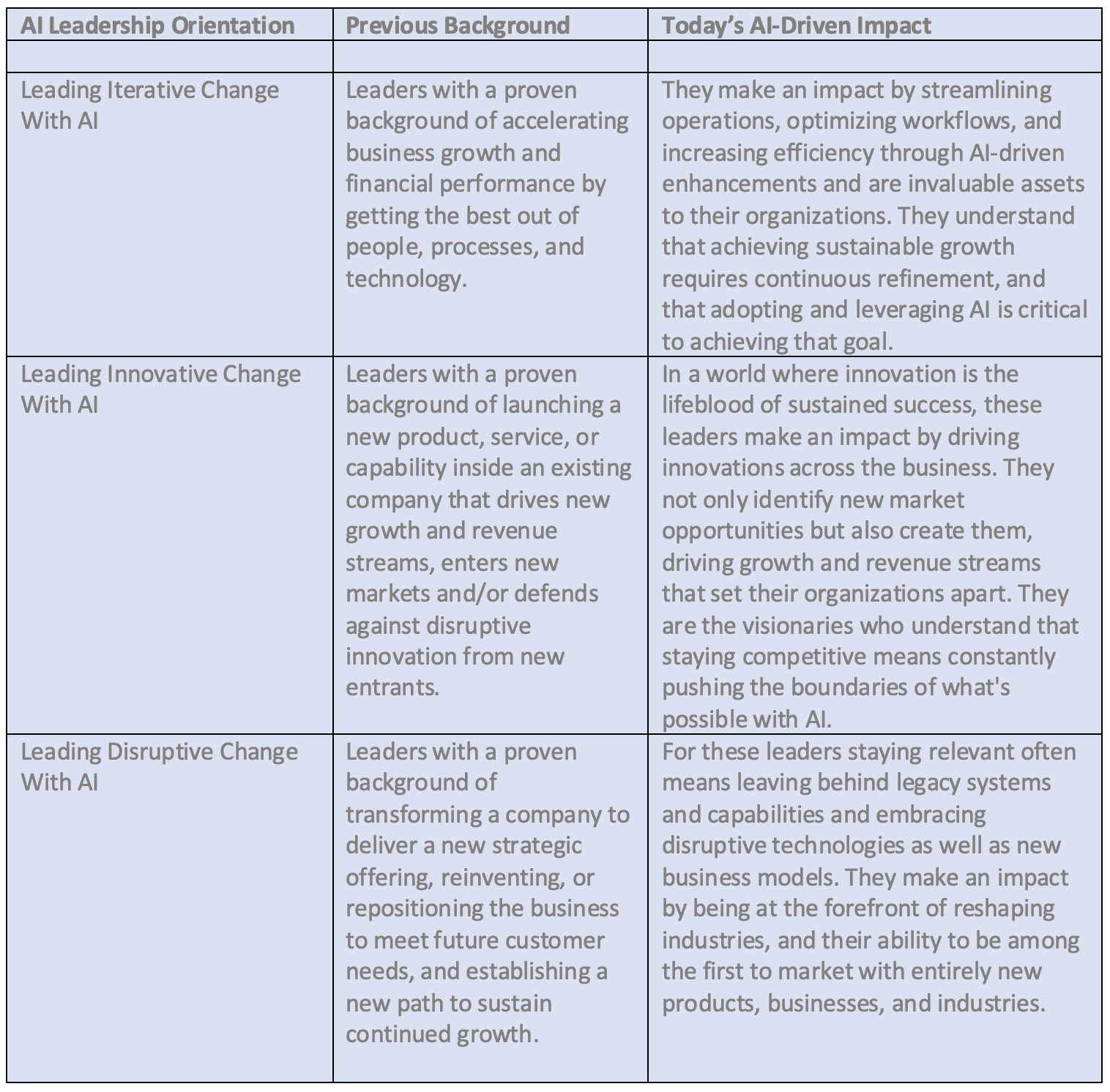Mastering Change in an AI-Driven World
Artificial Intelligence (AI) is already disrupting existing industries and creating new markets, and that level and pace of change demands new leadership archetypes. The ability to drive change is now a critical skill for leaders to meet the challenges of AI-driven transformation. Change leadership specific to AI for many firms, will make the difference between realizing goals and innovating for future success, or chronic underperformance.
CEOs, Boards and Clients are preparing and looking for leaders who not only understand AI but can lead the organization to adopt and adapt to AI opportunities, and successfully navigate through the certain massive disruption we will witness across industries for years to come.
AI-Driven Change as a Leadership Skill
To thrive in this era, one must not only adapt but also actively lead change. This article builds upon our previous framework for AI-driven change, explores the concept of change as a leadership skill, and highlights three types of “Leaders of AI-Driven Change”. As described in Table 1, each of the three provides valuable high-performance leadership, but for different reasons, with respect to business needs, phases of growth and levels of AI-driven change.
Table 1. Three Leadership Archetypes for AI-Driven Change
Leading Iterative Change With AI
These leaders focus on enhancing existing processes, making them better, faster, more efficient, or scalable by leveraging AI technologies. They have a proven background in improving something that already exists. Iterative AI change leadership can manifest itself in the following ways:
- At an individual level, for everyday activities (emails, reports, research, strategy, marketing, sales, and customer insights) they will be utilizing Generative (Gen) AI text and computer code generation tools such as OpenAI’s ChatGPT (funded by Microsoft), Google’s Bard, Meta’s Llama, and Anthropic’s Claude (pending an Amazon acquisition). Thanks to AI the cost of cognition – how we gather information, think about it, how long it takes, who we collaborate with – is dropping to zero. Large Language Model Gen AI tools can provide everyone with their own smart assistant (research associate, access to best business minds and industry experts, summarizer of large documents, case study and report writer, idea generator, thought partner and copy editor) to do more, faster and with better outcomes. Please click here for more examples and getting started.
- At a company level, these leaders can significantly enhance iterative change by engaging teams to apply AI solutions for gathering and analyzing vast amounts of data to identify patterns, trends, and customer preferences. The current set of most common use cases of Gen AI tools are in Marketing and Sales (crafting first drafts of text documents, personalized marketing, summarizing text documents), Product and Service Development (identifying trends in customer needs, drafting technical documents, creating new product design), Service Operations (use of chatbots, forecasting service trends or anomalies) and Customer Experience Management (capturing voice of customer and operational data from multiple sources, providing analytics, metrics and actionable intelligence to win, grow and keep more high value customers).
These leaders deliver AI-driven change by understanding that much of iterative change can be done by individual employees. Leaders need only do a few things to enable employees to make those changes. The first is to establish simple and reasonable guidelines so that employees are clear about what they are and are not allowed to do with AI. The second is to provide educational resources. The third, and perhaps most important factor, is to encourage employees to take the time to master these new tools.
Such leaders make an impact by streamlining operations, optimizing workflows, and increasing efficiency through AI-driven enhancements and are invaluable assets to their organizations. They understand that achieving sustainable growth requires continuous refinement, and AI is a powerful tool in their arsenal to achieve that.
Leading Innovative Change With AI
These leaders are pioneers in offering new things that create new value through AI. They have a proven background in launching groundbreaking products, services, or capabilities within their organizations, effectively redefining market standards. Innovative AI change leadership can manifest itself in the following ways:
- Leveraging AI’s ability to process and analyze complex data sets that lead to the discovery of novel insights and opportunities. It can be used to identify unmet customer needs, create personalized experiences, and even predict future trends. This leads to innovative solutions that differentiate you from the competition. Additionally, AI can automate repetitive tasks, enabling employees to focus on higher-value activities that drive innovation.
- Applications include fully automated (without human intervention) AI generated content such as marketing materials and news articles based on data and patterns. This allows businesses to produce content faster and maintain an active online presence, pleasing customers with up-to-date information. Another application is AI-powered health monitoring wearables that continuously track health metrics and provide personalized insights. This allows individuals to proactively manage their health goals as well as receive more accurate diagnoses and identification of subtle anomalies, leading to improved treatment. Please click here for more examples.
These leaders deliver AI-driven change by understanding that Innovative change won’t happen without strong support across the top leadership team. These are some of the questions they ask:
- Do we have the right people to discover opportunities for innovative change? Are there bright, curious people who can think outside of the current ways of doing things?
- Do we have managers who can implement innovative change? Are there managers who are capable change leaders who can tackle the complexities of introducing innovations?
- Do we have leaders who provide all the needed support for innovative change? Do leaders provide time and resources for people to experiment?
- Are failures punished or seen as learning opportunities? Are leaders savvy to the organizational issues that act as barriers to innovative change and act to overcome them?
These leaders not only identify new market opportunities but also create them, driving growth and revenue streams that set their organizations apart. They are the visionaries who understand that staying competitive means constantly pushing the boundaries of what’s possible with AI.
Leading Disruptive Change With AI
These leaders specialize in offering new solutions that render old ones obsolete. They are experts in transforming companies to deliver new strategic offerings, reinventing, or repositioning the business to meet future customer needs and establishing a new path to sustained growth through AI. Disruptive AI change leadership can manifest itself in the following ways:
- When facing AI-driven disruption organizations may need to rethink their strategies and adapt quickly to remain competitive as was the case with Google, who called a“Code Red” due to the disruptive impact AI could have on their search business. Disruptive change is doing new things that make old things obsolete and that’s why the Hollywood writers and actors were worried enough about AI disrupting their industry that it contributed to them going on strike.
- Leading companies have been using AI for years. Amazon for example uses AI recommendation engines to drive buying, and AI robotics to create hyper-efficient distribution centers. Amazon would not have disrupted the retail industry had it not made extensive use of AI throughout all parts of its business. Another is Uber’s disruption of the taxi industry, and now all forms of delivery services. Uber relies on AI to match customers with drivers. Drivers rely on directions given by AI-powered maps. Please click here for more examples
These leaders deliver AI-driven change by understanding that disruptive change, doing new things that make the old things obsolete, won’t happen without strong support from the CEO, board, and investors.
This is where you start to disrupt the market to meet the emerging and future needs of your customers. Unless you have a Steve Jobs in your company the ideas for disruptive change will likely come from multiple innovations and a combination of successes with customers that point to a new disruptive business model to delight them.
For these leaders staying relevant means leaving behind legacy systems and ways of working and embracing disruptive technologies and new business models. They make an impact by being at the forefront of reshaping industries, and their ability to drive change at this level can be the difference between creating new industries and obsolescence.
In Conclusion
Mastering change in an AI-driven world has become an indispensable leadership skill. Leaders must not only embrace change but actively cultivate it as a skill. Those who excel in leading iterative, innovative, and disruptive change with AI will shape the future of their organizations and industries.
The best companies are those that recognize change as a skill to be developed, practiced, and refined, and their Leaders of AI-driven change are at the forefront of this journey to the future.
The forward-thinking leaders will be proactively challenging themselves by asking “Which of the types of ‘Leaders of Change’ have I been in the past and which of the 3 ‘Leaders of AI-Driven Change’ do I need to be an expert in to achieve the goals I have set myself?”
Transformative Artificial Intelligence (AI) will demand a new set of leadership archetypes. If you have interest to explore which ‘Leaders of AI-Driven Change’ you need most on your team, let’s chat.
Back to Insights


